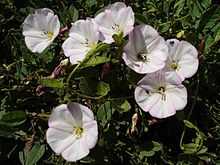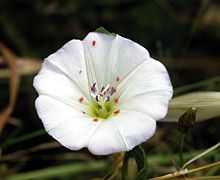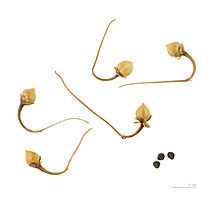Convolvulus arvensis
| Convolvulus arvensis | |
|---|---|
 | |
| Scientific classification | |
| Kingdom: | Plantae |
| (unranked): | Angiosperms |
| (unranked): | Eudicots |
| (unranked): | Asterids |
| Order: | Solanales |
| Family: | Convolvulaceae |
| Genus: | Convolvulus |
| Species: | C. arvensis |
| Binomial name | |
| Convolvulus arvensis L. | |
Convolvulus arvensis (field bindweed) is a species of bindweed in the morning glory family (Convolvulaceae), native to Europe and Asia. It is a climbing or creeping herbaceous perennial plant growing to 0.5–2 m high. The leaves are spirally arranged, linear to arrowhead-shaped, 2–5 cm long and alternate, with a 1–3 cm petiole. The flowers are trumpet-shaped, 1-2.5 cm diameter, white or pale pink, with five slightly darker pink radial stripes. Flowering occurs in the mid-summer, when white to pale pink, funnel-shaped flowers develop. Flowers are approximately 0.75-1 in. (1.9-2.5 cm) across and are subtended by small bracts. Fruit are light brown, rounded and 1/8 in. (0.3 cm) wide. Each fruit contains 2 seeds that are eaten by birds and can remain viable in the soil for decades. Bindweed contains several alkaloids, including pseudotropine, and lesser amounts of tropine, tropinone, and meso-cuscohygrine.[1]


There are two varieties:
- Convolvulus arvensis var. arvensis. Leaves broader.
- Convolvulus arvensis var. linearifolius. Leaves narrower.
Although it produces attractive flowers, it is often unwelcome in gardens as a nuisance weed due to its rapid growth and choking of cultivated plants. It was most likely introduced into North America as a contaminant in crop seed as early as 1739, as an invasive species. Plants typically inhabit roadsides, grasslands and also along streams. Its dense mats invade agricultural fields and reduce crop yields; it is estimated that crop losses due to this plant in the United States exceeded US$377 million in the year 1998 alone.[2]
Other common names, mostly obsolete, include lesser bindweed, European bindweed, withy wind (in basket willow crops), perennial morning glory, smallflowered morning glory, creeping jenny, and possession vine. It is called leli in Punjabi.
In one of the tales collected by Jacob and Wilhelm Grimm, Our Lady's Little Glass, this flower is used by Our Lady to drink wine with when she helps free a wagoner's cart. The story goes on to say that "the little flower is still always called Our Lady's Little Glass."
Ecological Impacts: Field bindweed intertwines and topples native species. It competes with other species for sunlight, moisture and nutrients. It poses threats to restoration efforts and riparian corridors by choking out grasses and forbs. It can decrease habitat biodiversity. It is one of the most serious weeds of agricultural fields in temperate regions of the world.
Toxicity: Mildly toxic to grazing animals
Control and Management: Field bindweed is difficult to eradicate because the seeds remain viable in soil for up to 20 years. One plant can produce up to 500 seeds. The deep, extensive root system stores carbohydrates and proteins and allows it to sprout repeatedly from fragments and rhizomes following removal of aboveground growth.
- Manual- Discing, tilling or hand pulling
- Chemical- Apply herbicide 2,4-D or glyphosate (Roundup); applications that trans-locate to roots,
before seeds set
- Other approaches: Research suggests that shading will help control this species; mulching using
paper, straw, wood chips, or black plastic can be effective in certain areas
- Natural Enemies: Eight fungi and ten arthropods have been found on members of the genus Convolvulus.
References:
- http://www.fs.fed.us/database/feis/plants/vine/conarv/all.html
- www.plantatlas.usf.edu/images.asp?plantID=1755
- http://plants.usda.gov/cgi_bin/topics.cgi?earl=noxious.cgi *dead link*
- Invasive Plants of Asia Origin Established in the US and their Natural Enemies p. 58-59
- WSSA-1,000 Weeds of North America: An Identification Guide
- ELEMENT STEWARDSHIP ABSTRACT- http://tncweeds.ucdavis.edu/esadocs/documnts/convarv.rtf *dead link*
- Federal Noxious Weed Disseminules in the US -
- www.lucidcentral.org/keys/FNW/FNW%20seeds/html/fact%20sheets/Convolvulus%20arvensis.htm
References
- ↑ Vet Hum Toxicol. 1995 Oct;37(5):452-4. Toxicity of field bindweed (Convolvulus arvensis) to mice. Schultheiss PC1, Knight AP, Traub-Dargatz JL, Todd FG, Stermitz FR.
- ↑ Coombs, E. M., et al., Eds. (2004). Biological Control of Invasive Plants in the United States. Corvallis: Oregon State University Press, 151.
- Blanchan, Neltje (2002). Wild Flowers: An Aid to Knowledge of Our Wild Flowers and Their Insect Visitors. Project Gutenberg Literary Archive Foundation.
- Flora Europaea: Convolvulus arvensis
- Flora of China: Convolvulus arvensis
- Invasive.org: Convolvulus arvensis
- PLANTS Profile: Convolvulus arvensis (field blindweed) | USDA PLANTS
External links
| Wikimedia Commons has media related to Convolvulus arvensis. |
| Wikispecies has information related to: Convolvulus arvensis |